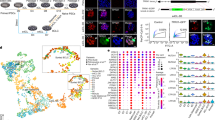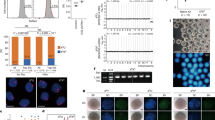Abstract
Until now, animal cloning and the production of embryonic stem cell lines by somatic cell nuclear transfer have relied on introducing nuclei into meiotic oocytes. In contrast, attempts at somatic cell nuclear transfer into fertilized interphase zygotes have failed. As a result, it has generally been assumed that unfertilized human oocytes will be required for the generation of tailored human embryonic stem cell lines from patients by somatic cell nuclear transfer. Here we report, however, that, unlike interphase zygotes, mouse zygotes temporarily arrested in mitosis can support somatic cell reprogramming, the production of embryonic stem cell lines and the full-term development of cloned animals. Thus, human zygotes and perhaps human embryonic blastomeres may be useful supplements to human oocytes for the creation of patient-derived human embryonic stem cells.
This is a preview of subscription content, access via your institution
Access options
Subscribe to this journal
Receive 51 print issues and online access
$199.00 per year
only $3.90 per issue
Buy this article
- Purchase on Springer Link
- Instant access to full article PDF
Prices may be subject to local taxes which are calculated during checkout





Similar content being viewed by others
References
McGrath, J. & Solter, D. Nuclear transplantation in the mouse embryo by microsurgery and cell fusion. Science 220, 1300–1302 (1983)
McGrath, J. & Solter, D. Inability of mouse blastomere nuclei transferred to enucleated zygotes to support development in vitro. Science 226, 1317–1319 (1984)
Robl, J. M. et al. Nuclear transplantation in bovine embryos. J. Anim. Sci. 64, 642–647 (1987)
Willadsen, S. M. Nuclear transplantation in sheep embryos. Nature 320, 63–65 (1986)
Stice, S. L. & Robl, J. M. Nuclear reprogramming in nuclear transplant rabbit embryos. Biol. Reprod. 39, 657–664 (1988)
Prather, R. S., Sims, M. M. & First, N. L. Nuclear transplantation in early pig embryos. Biol. Reprod. 41, 414–418 (1989)
Cheong, H. T., Takahashi, Y. & Kanagawa, H. Development of mouse embryonic nuclei transferred to enucleated oocytes and zygotes. Jpn. J. Vet. Res. 40, 149–159 (1992)
Campbell, K. H., McWhir, J., Ritchie, W. A. & Wilmut, I. Sheep cloned by nuclear transfer from a cultured cell line. Nature 380, 64–66 (1996)
Wilmut, I., Schnieke, A. E., McWhir, J., Kind, A. J. & Campbell, K. H. Viable offspring derived from fetal and adult mammalian cells. Nature 385, 810–813 (1997)
Wakayama, T., Perry, A. C., Zuccotti, M., Johnson, K. R. & Yanagimachi, R. Full-term development of mice from enucleated oocytes injected with cumulus cell nuclei. Nature 394, 369–374 (1998)
Chesne, P. et al. Cloned rabbits produced by nuclear transfer from adult somatic cells. Nature Biotechnol. 20, 366–369 (2002)
Polejaeva, I. A. et al. Cloned pigs produced by nuclear transfer from adult somatic cells. Nature 407, 86–90 (2000)
Kato, Y. et al. Eight calves cloned from somatic cells of a single adult. Science 282, 2095–2098 (1998)
Zhou, Q. et al. Generation of fertile cloned rats by regulating oocyte activation. Science 302, 1179 (2003)
Wakayama, T., Tateno, H., Mombaerts, P. & Yanagimachi, R. Nuclear transfer into mouse zygotes. Nature Genet. 24, 108–109 (2000)
Schurmann, A., Wells, D. N. & Oback, B. Early zygotes are suitable recipients for bovine somatic nuclear transfer and result in cloned offspring. Reproduction 132, 839–848 (2006)
Steinbrook, R. Egg donation and human embryonic stem-cell research. N. Engl. J. Med. 354, 324–326 (2006)
Norsigian, J. in Boston Globe 25 February. A13 (2005)
Do, J. T. & Scholer, H. R. Nuclei of embryonic stem cells reprogram somatic cells. Stem Cells 22, 941–949 (2004)
Takahashi, K. & Yamanaka, S. Induction of pluripotent stem cells from mouse embryonic and adult fibroblast cultures by defined factors. Cell 126, 663–676 (2006)
Gao, S. et al. Germinal vesicle material is essential for nucleus remodeling after nuclear transfer. Biol. Reprod. 67, 928–934 (2002)
Rudner, A. D. & Murray, A. W. The spindle assembly checkpoint. Curr. Opin. Cell Biol. 8, 773–780 (1996)
Hamilton, B. T. & Snyder, J. A. Rapid completion of mitosis and cytokinesis in PtK cells following release from nocodazole arrest. Eur. J. Cell Biol. 28, 190–194 (1982)
Glotzer, M., Murray, A. W. & Kirschner, M. W. Cyclin is degraded by the ubiquitin pathway. Nature 349, 132–138 (1991)
Ehrhardt, A. G. & Sluder, G. Spindle pole fragmentation due to proteasome inhibition. J. Cell. Physiol. 204, 808–818 (2005)
Cheong, H. T. & Kanagawa, H. Assessment of cytoplasmic effects on the development of mouse embryonic nuclei transferred to enucleated zygotes. Theriogenology 39, 451–461 (1993)
Wakayama, T., Rodriguez, I., Perry, A. C., Yanagimachi, R. & Mombaerts, P. Mice cloned from embryonic stem cells. Proc. Natl Acad. Sci. USA 96, 14984–14989 (1999)
Beck, F., Erler, T., Russell, A. & James, R. Expression of Cdx-2 in the mouse embryo and placenta: possible role in patterning of the extra-embryonic membranes. Dev. Dyn. 204, 219–227 (1995)
Niwa, H. et al. Interaction between Oct3/4 and Cdx2 determines trophectoderm differentiation. Cell 123, 917–929 (2005)
Eggan, K. et al. Hybrid vigor, fetal overgrowth, and viability of mice derived by nuclear cloning and tetraploid embryo complementation. Proc. Natl Acad. Sci. USA 98, 6209–6214 (2001)
Yoshimizu, T. et al. Germline-specific expression of the Oct-4/green fluorescent protein (GFP) transgene in mice. Dev. Growth Differ. 41, 675–684 (1999)
Scholer, H. R., Dressler, G. R., Balling, R., Rohdewohld, H. & Gruss, P. Oct-4: a germline-specific transcription factor mapping to the mouse t-complex. EMBO J. 9, 2185–2195 (1990)
Boiani, M., Eckardt, S., Scholer, H. R. & McLaughlin, K. J. Oct4 distribution and level in mouse clones: consequences for pluripotency. Genes Dev. 16, 1209–1219 (2002)
Greda, P., Karasiewicz, J. & Modlinski, J. A. Mouse zygotes as recipients in embryo cloning. Reproduction 132, 741–748 (2006)
Tada, M., Tada, T., Lefebvre, L., Barton, S. C. & Surani, M. A. Embryonic germ cells induce epigenetic reprogramming of somatic nucleus in hybrid cells. EMBO J. 16, 6510–6520 (1997)
Tada, M., Takahama, Y., Abe, K., Nakatsuji, N. & Tada, T. Nuclear reprogramming of somatic cells by in vitro hybridization with ES cells. Curr. Biol. 11, 1553–1558 (2001)
Cowan, C. A., Atienza, J., Melton, D. A. & Eggan, K. Nuclear reprogramming of somatic cells after fusion with human embryonic stem cells. Science 309, 1369–1373 (2005)
Ono, Y., Shimozawa, N., Ito, M. & Kono, T. Cloned mice from fetal fibroblast cells arrested at metaphase by a serial nuclear transfer. Biol. Reprod. 64, 44–50 (2001)
Hall, V. J. et al. Developmental competence of human in vitro aged oocytes as host cells for nuclear transfer. Hum. Reprod. 22, 52–62 (2007)
Wakayama, S. et al. Establishment of mouse embryonic stem cell lines from somatic cell nuclei by nuclear transfer into aged, fertilization-failure mouse oocytes. Curr. Biol. 17, R120–R121 (2007)
Wakayama, S. et al. Production of offspring from one-day-old oocytes stored at room temperature. J. Reprod. Dev. 50, 627–637 (2004)
Nikolettos, N. & Al-Hasani, S. Frozen pronuclear oocytes: advantages for the patient. Mol. Cell. Endocrinol. 169, 55–62 (2000)
Damario, M. A., Hammitt, D. G., Galanits, T. M., Session, D. R. & Dumesic, D. A. Pronuclear stage cryopreservation after intracytoplasmic sperm injection and conventional IVF: implications for timing of the freeze. Fertil. Steril. 72, 1049–1054 (1999)
Van der Ven, H. H. et al. Polyspermy in in vitro fertilization of human oocytes: frequency and possible causes. Ann. NY Acad. Sci. 442, 88–95 (1985)
Munne, S. & Cohen, J. Chromosome abnormalities in human embryos. Hum. Reprod. Update 4, 842–855 (1998)
Kola, I., Trounson, A., Dawson, G. & Rogers, P. Tripronuclear human oocytes: altered cleavage patterns and subsequent karyotypic analysis of embryos. Biol. Reprod. 37, 395–401 (1987)
Anon. Assisted reproductive technology in the United States: 2000 results generated from the American Society for Reproductive Medicine/Society for Assisted Reproductive Technology Registry. Fertil. Steril. 81, 1207–1220 (2004)
Sathananthan, A. H. et al. Centrioles in the beginning of human development. Proc. Natl Acad. Sci. USA 88, 4806–4810 (1991)
Beard, C., Hochedlinger, K., Plath, K., Wutz, A. & Jaenisch, R. Efficient method to generate single-copy transgenic mice by site-specific integration in embryonic stem cells. Genesis 44, 23–28 (2006)
Wakayama, T. & Yanagimachi, R. Cloning of male mice from adult tail-tip cells. Nature Genet. 22, 127–128 (1999)
Nagy, A., Gertsenstein, M., Vintersten, K. & Behringer, R. Manipulating the Mouse Embryo: A Laboratory Manual 3rd edn (Cold Spring Harbor Laboratory Press, New York, 2003)
Wolf, J. P. et al. Absence of block to polyspermy at the human oolemma. Fertil. Steril. 67, 1095–1102 (1997)
Strumpf, D. et al. Cdx2 is required for correct cell fate specification and differentiation of trophectoderm in the mouse blastocyst. Development 132, 2093–2102 (2005)
Acknowledgements
We thank A. Murray for insight into the regulation of the cell cycle; K. Hochedlinger and C. Beard for KH2 ES cells and plasmids; A. Greenwood for H2B and cherry plasmids; C. Cowan, K. Niakan, J. Dimos, I. Tabansky, W. Strausack, A. Schier, A. McMahon, R. Jaenisch and D. Melton for advice and discussions; and D. Melton, A. Schier, D. Lopez, R. Jaenisch, A. Meissner, A. McMahon, A. Murray and A. Chen for critical reading of the manuscript. This work was supported by funds from the Stowers Medical Institute, The Harvard Stem Cell Institute and the National Institutes of Health to K.E. and by a fellowship from the Swiss National Science Foundation to D.E. K.E. is a fellow of the John D. and Catherine T. MacArthur Foundation.
Author Contributions K.E. and D.E. designed the experiments. D.E. constructed the H2B-cherry mouse ES cell line and mouse. D.E., J.R. and K.E. performed chromosome transfer experiments and stem cell derivation. G.B. assisted D.E. with blastocyst injections and embryo transfer and prepared the figures. K.E. and D.E. wrote the paper. All authors discussed the results and commented on the manuscript.
Author information
Authors and Affiliations
Corresponding author
Ethics declarations
Competing interests
Reprints and permissions information is available at www.nature.com/reprints. The authors declare no competing financial interests.
Supplementary information
Supplementary Information
This file contains Supplementary Methods, Supplementary Tables 1-4, Supplementary Figures 1-5 with Legends, additional experimental information and additional references. (PDF 13403 kb)
Supplementary Video 1
This file contains Supplementary Video 1. (MOV 5909 kb)
Supplementary Video 2
This file contains Supplementary Video 2. (MOV 1303 kb)
Rights and permissions
About this article
Cite this article
Egli, D., Rosains, J., Birkhoff, G. et al. Developmental reprogramming after chromosome transfer into mitotic mouse zygotes. Nature 447, 679–685 (2007). https://doi.org/10.1038/nature05879
Received:
Accepted:
Issue Date:
DOI: https://doi.org/10.1038/nature05879
This article is cited by
-
Perivascular niche cells sense thrombocytopenia and activate hematopoietic stem cells in an IL-1 dependent manner
Nature Communications (2023)
-
Regulated interaction of ID2 with the anaphase-promoting complex links progression through mitosis with reactivation of cell-type-specific transcription
Nature Communications (2022)
-
Chromatin architecture reorganization in murine somatic cell nuclear transfer embryos
Nature Communications (2020)
-
Inter-homologue repair in fertilized human eggs?
Nature (2018)
-
Genomic instability during reprogramming by nuclear transfer is DNA replication dependent
Nature Cell Biology (2017)
Comments
By submitting a comment you agree to abide by our Terms and Community Guidelines. If you find something abusive or that does not comply with our terms or guidelines please flag it as inappropriate.



